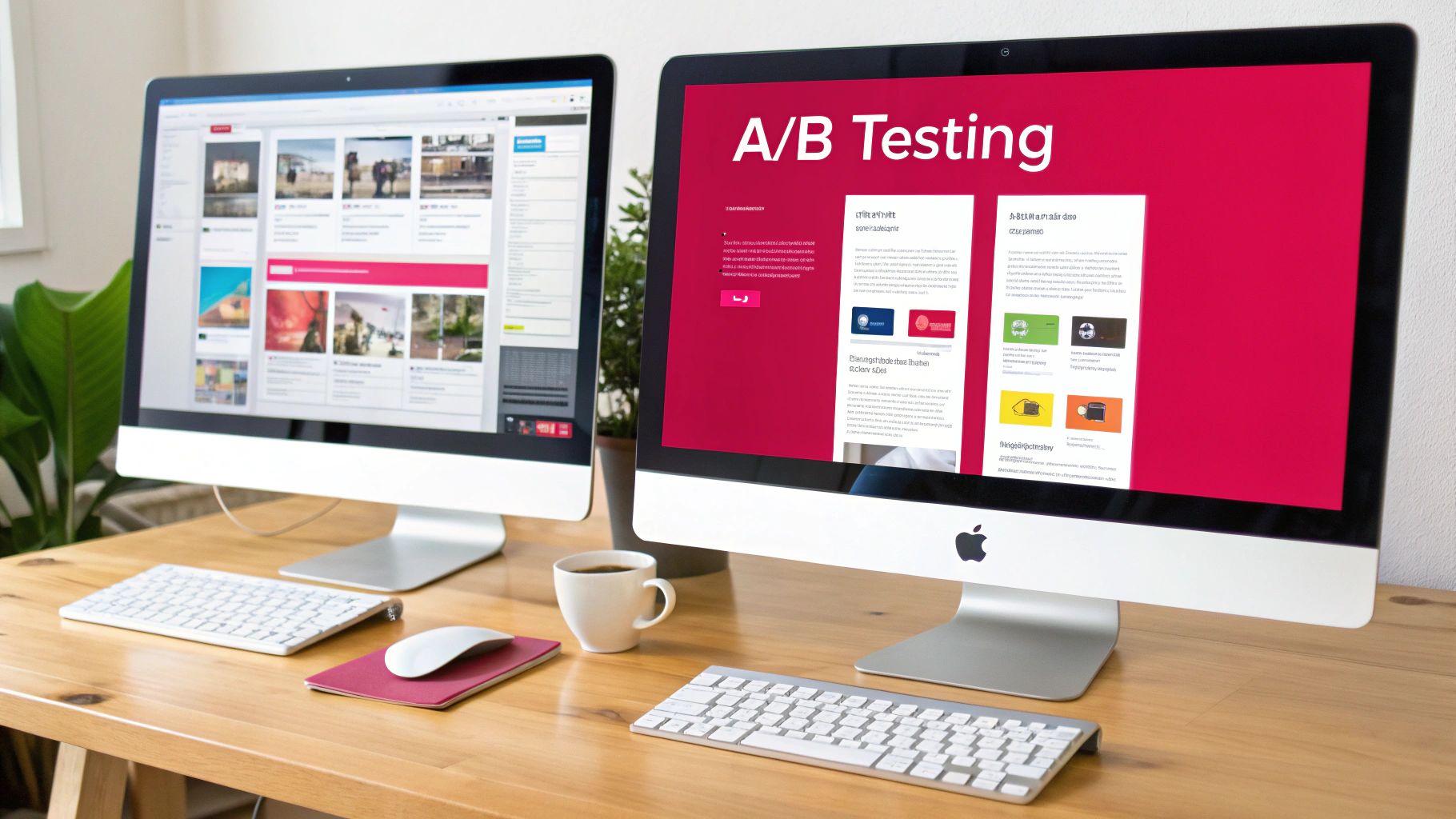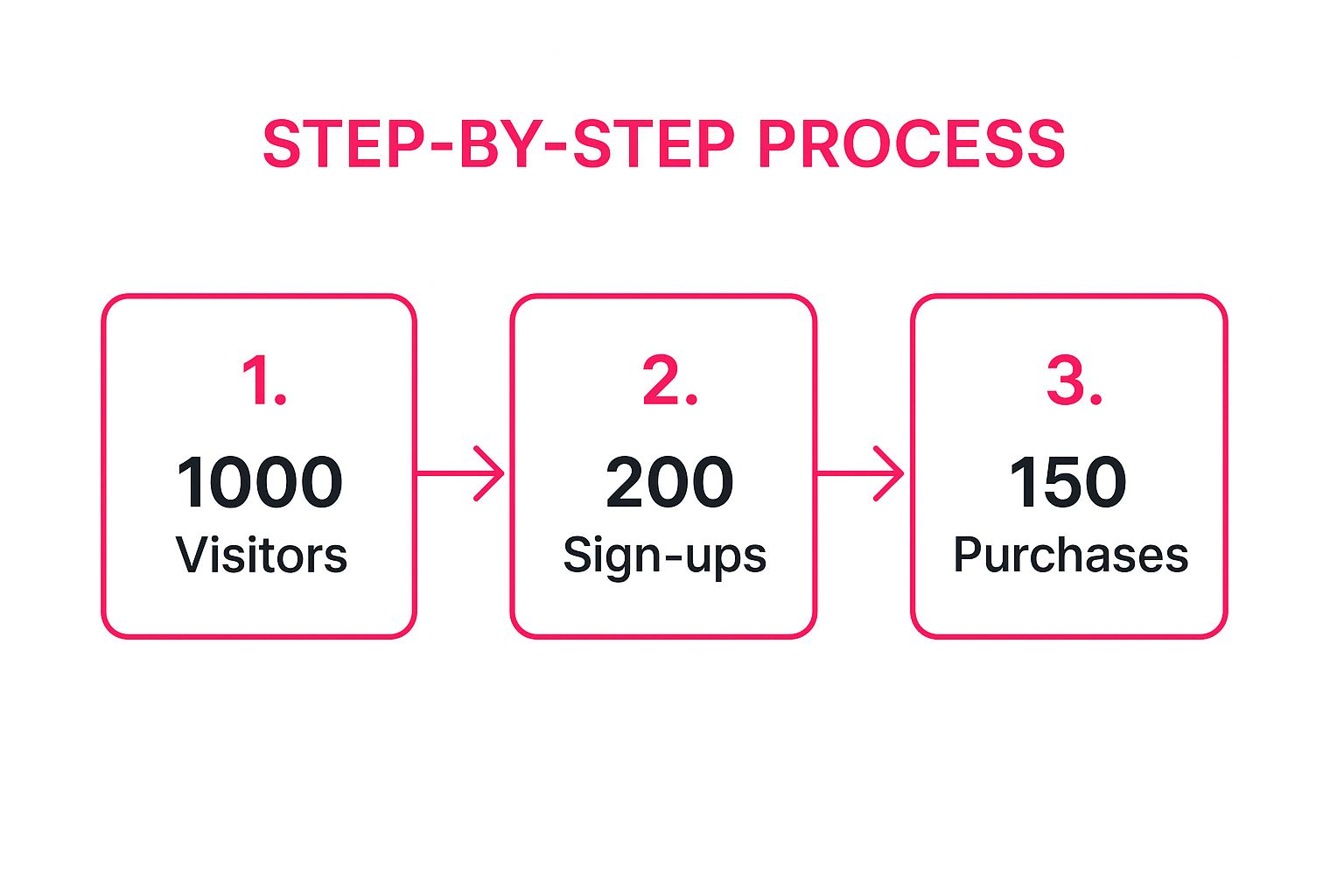In an increasingly competitive digital marketplace, simply having a website is not enough. The real challenge lies in methodically turning visitors into customers, and this is where Conversion Rate Optimisation (CRO) becomes your most valuable asset. The days of guessing what works or simply changing a button colour are over. Modern CRO is a rigorous discipline, blending deep user psychology with data analysis to build persuasive user journeys. Relying on outdated tactics means leaving revenue on the table, a risk that businesses, especially in dynamic markets like the UAE, cannot afford.
This comprehensive guide moves beyond generic advice. We will provide ten actionable, data-backed conversion rate optimization best practices that promise to deliver measurable growth. You will learn to implement everything from sophisticated A/B testing frameworks and compelling call-to-action design to the nuanced art of mobile-first form optimisation and advanced user analytics. As traditional methods evolve, understanding the broader implications of artificial intelligence becomes essential for modern CRO; forward-thinking leaders are already exploring how Künstliche Intelligenz im Marketing is shaping the future of personalisation and data interpretation.
Our goal is to equip you with a powerful toolkit. By mastering these principles, you will gain the ability not just to attract traffic, but to convert it with precision and efficiency. The following strategies are designed to be implemented immediately, helping you diagnose weaknesses in your conversion funnel, create superior user experiences, and ultimately, drive significant business results.
1. A/B Testing and Experimentation
A/B testing, also known as split testing, is the cornerstone of data-driven optimisation. It’s a controlled experiment where you compare two or more versions of a webpage or app screen to see which one performs better. By showing a control version (A) to one segment of your audience and a variation (B) to another, you can definitively measure which one achieves a higher conversion rate based on real user behaviour, not assumptions.

This method eliminates guesswork from your marketing strategy. Giants like Booking.com continuously test urgency-inducing messages ("Only 2 rooms left!"), while Netflix famously tests thumbnail images to maximise viewer engagement. This systematic approach is a fundamental component of any serious conversion rate optimisation best practices framework.
Actionable Tips for Effective A/B Testing
To get reliable results, your testing process must be structured and methodical. Vague tests lead to inconclusive data, wasting valuable time and traffic.
- Isolate Your Variables: Test only one element at a time. If you change the headline, call-to-action (CTA) button colour, and an image all at once, you will not know which change caused the uplift or decline in conversions.
- Ensure Statistical Significance: Do not end a test prematurely. Use a sample size calculator to determine how many visitors you need before you can trust the results. Concluding too early can lead you to implement a false winner.
- Focus on High-Impact Pages: Start by testing elements on pages that have high traffic but low conversion rates, such as your homepage, pricing pages, or key landing pages. Small improvements here can yield significant business results.
- Document Everything: Keep a detailed log of every test you run, including your hypothesis, the variations, the results, and the key learnings. This repository becomes an invaluable internal resource for your entire organisation.
2. Optimized Landing Page Design
An optimised landing page is a standalone web page created specifically for a marketing or advertising campaign. Its sole purpose is to capture leads or drive a specific action, making it a critical element in any high-performing conversion funnel. Unlike a homepage with multiple navigation options and goals, a landing page is hyper-focused, eliminating distractions to guide the visitor towards a single, desired conversion event.

This focused approach is a cornerstone of modern conversion rate optimisation best practices. For instance, Dropbox famously used a simple, benefit-driven landing page to accelerate user growth, while platforms like Unbounce have built their entire business on enabling marketers to create and test dedicated pages for every campaign. By aligning the page's message and design with the visitor's intent from the initial ad click, you create a seamless and persuasive user journey.
Actionable Tips for Effective Landing Page Design
A successful landing page is a strategic blend of persuasive copy, intuitive design, and a clear call-to-action. Each element must work in harmony to convince the user to convert.
- Maintain Message Match: The headline and core message on your landing page must directly reflect the ad or link the visitor clicked to get there. This consistency reassures users they are in the right place and reduces bounce rates.
- Create a Compelling Above-the-Fold Experience: The content visible without scrolling is your most valuable real estate. It must immediately communicate your value proposition with a powerful headline, concise supporting copy, and an engaging visual.
- Leverage Social Proof: Integrate trust signals like customer testimonials, case study snippets, media logos, or user ratings. This builds credibility and reduces visitor anxiety, making them more comfortable with converting.
- Minimise Friction: Every field you ask a user to fill in adds friction. Only ask for the absolute essential information needed for the conversion. For lead generation, you can often get by with just an email address, gathering more data later.
3. Compelling Call-to-Action (CTA) Optimisation
Your call-to-action (CTA) is the gateway to conversion. It is the specific button, link, or text that prompts a user to take a desired action. Strategic CTA optimisation involves much more than just a bright button; it combines persuasive copy, prominent placement, and psychological principles to guide users from passive browsing to active engagement. A weak or unclear CTA creates a dead end in the user journey, while a powerful one acts as a clear, compelling instruction.

This practice is fundamental to any high-performing digital asset. For instance, Netflix famously increased sign-ups by shifting from a generic "Register" to a value-driven "Join Free for a Month". Similarly, Spotify’s "Get Spotify Free" immediately highlights the no-cost benefit, reducing friction. These examples show how effective CTAs are a critical component of conversion rate optimisation best practices, directly influencing user decisions.
Actionable Tips for Effective CTA Optimisation
A well-crafted CTA can dramatically lift your conversion rates, but it requires thoughtful design and testing. Avoid generic phrases and focus on creating a sense of value and urgency.
- Use Action-Oriented, First-Person Language: Instead of a passive "Submit", try a more personal and benefit-focused phrase like "Get My Free Quote". First-person copy ("my" instead of "your") has been shown to resonate more strongly with users.
- Create Visual Contrast: Your CTA must stand out from the rest of the page. Use contrasting colours, ample white space, and a size that is easily tappable on mobile devices. It should be impossible to miss.
- Communicate Value, Not Action: The best CTAs answer the user's question, "What's in it for me?". "Start Learning Today" is more compelling than "Sign Up" because it focuses on the outcome. For a deeper dive, exploring the art of designing effective calls to action to drive conversions can provide further valuable insights.
- Test Everything: Do not assume you know what works best. A/B test your CTA's copy, colour, size, shape, and placement. A small change, like button colour, can sometimes lead to a significant increase in clicks and conversions.
4. Social Proof and Trust Signals
Social proof is the psychological phenomenon where people assume the actions of others reflect correct behaviour for a given situation. In digital marketing, this translates to using testimonials, reviews, and trust badges to reassure potential customers that they are making a wise decision. When visitors see that others have purchased from you and had a positive experience, it significantly reduces their buying anxiety and builds immediate credibility.
This principle is a core driver of success for platforms like Amazon, where customer reviews are integral to the buying process. Similarly, Booking.com leverages social proof by showing how many people are currently viewing a hotel or have recently booked it. Integrating these elements is one of the most powerful conversion rate optimisation best practices because it taps directly into the human need for validation.
Actionable Tips for Effective Social Proof
To build trust effectively, your social proof must be authentic, visible, and relevant. Simply having a testimonial page is not enough; it needs to be woven into the customer journey.
- Display Reviews Prominently: Do not hide your reviews. Integrate star ratings and customer feedback directly on product and service pages, near the price and "Add to Cart" button, where they have the most impact.
- Enhance Testimonials: Make testimonials more believable by including the customer's full name, a high-quality photo, their company, and their location. Vague praise from "John S." is far less powerful than a detailed account from a verifiable person.
- Show Real-Time Activity: Use tools to display notifications like "Someone in Dubai just purchased this item". This creates a sense of urgency and reinforces the product's popularity, a tactic used effectively by many e-commerce and travel sites.
- Use Industry-Specific Trust Badges: Display security seals (like SSL certificates), payment provider logos (Visa, Mastercard), and any industry awards or certifications. These signals reassure users that their data is safe and your business is legitimate.
5. Form Optimisation
Forms are the final gateway between a user's interest and a tangible conversion, whether it's a lead, a sale, or a subscription. Form optimisation is the process of strategically designing and refining these forms to reduce user friction and maximise completion rates. It involves a careful balance of minimising fields, improving the user experience, and applying psychological principles to guide users smoothly to the submit button.
A poorly designed form is a major conversion killer. Companies like Marketo famously boosted their conversion rate by 34% simply by reducing their form fields from nine to five. Platforms such as Typeform have built their entire business on making forms conversational and less intimidating, proving that a better form experience is a key part of any conversion rate optimisation best practices strategy.
Actionable Tips for Effective Form Optimisation
Optimising your forms requires a user-centric approach. Every field should justify its existence, and the entire process should feel intuitive and effortless for the user.
- Ask Only for Essential Information: Every additional field you add increases friction and cognitive load. Start by asking for the absolute minimum information needed to complete the initial conversion. You can always gather more data later using techniques like progressive profiling.
- Use Single-Column Layouts: For most forms, especially on mobile devices, a single-column layout is easier for users to follow. It creates a clear, linear path from top to bottom, preventing the user's eyes from darting around the page and reducing confusion.
- Implement Real-Time Validation: Provide immediate feedback as a user fills out the form. Use inline validation to show a green checkmark for correctly filled fields or a red error message if the information is incorrect. This prevents the frustration of submitting a form only to be told of multiple errors.
- Clearly Mark Optional Fields: Instead of marking every required field with an asterisk, consider marking only the few fields that are optional. This reframes the form as being shorter and less demanding, which can psychologically encourage completion.
6. Page Speed Optimisation
In the digital world, speed is not just a feature; it is a fundamental requirement for a positive user experience. Page speed optimisation involves improving how quickly your website's content loads for a visitor. A slow site frustrates users, leading to higher bounce rates and abandoned carts, which directly harms your conversion rate. Every millisecond counts, and optimising your load times is a critical component of any successful conversion rate optimisation best practices strategy.
The impact of speed on conversions is well-documented. Amazon famously calculated that a mere 100ms delay could cost them 1% in sales, while Walmart discovered that every 1-second improvement in page load time increased their conversions by up to 2%. These figures demonstrate that page speed is not just a technical metric; it is a powerful business lever.
Actionable Tips for Effective Page Speed Optimisation
To deliver a fast and responsive experience, you need a multi-faceted approach that addresses every element contributing to your site's load time. Focusing on these key areas will yield the most significant improvements.
- Optimise Your Images: Large, uncompressed images are often the biggest culprits of slow pages. Use modern image formats like WebP and tools to compress images without a noticeable loss in quality. Ensure images are also correctly sized for their containers.
- Leverage Browser Caching: Instruct browsers to store static resources, like CSS, JavaScript, and images, locally. When a user revisits your site, their browser can load these files from its cache instead of re-downloading them, dramatically speeding up load times.
- Minimise HTTP Requests: Each file on your page, from scripts to stylesheets, requires a separate HTTP request. Reduce these by combining CSS and JavaScript files, using CSS sprites for images, and eliminating unnecessary third-party scripts or plugins.
- Choose High-Performance Hosting: Your web hosting provider is the foundation of your site's performance. A cheap, shared hosting plan can throttle your speed. Invest in a reliable hosting solution that can handle your traffic and deliver content quickly.
- Continuously Monitor and Test: Use tools like Google's PageSpeed Insights or GTmetrix to regularly analyse your website's performance. These tools provide a detailed breakdown of what is slowing your site down and offer specific recommendations for improvement.
7. Mobile Optimisation
With mobile traffic now surpassing desktop for most industries, a mobile-first approach is no longer optional; it is a fundamental pillar of modern business. Mobile optimisation involves designing your website and conversion funnels to provide a seamless and intuitive experience for users on smartphones and tablets. This goes beyond simple responsive design and delves into touch-friendly navigation, faster load times, and context-specific user journeys.
Neglecting the mobile experience is equivalent to closing your doors to over half of your potential customers. Companies that excel here see massive returns; for instance, Domino's Pizza's user-friendly mobile ordering app has become a primary driver of its revenue growth. This demonstrates that effective mobile optimisation is one of the most impactful conversion rate optimisation best practices you can implement.
Actionable Tips for Effective Mobile Optimisation
A poor mobile experience creates friction and drives users to competitors. To capture and convert this massive audience segment, your mobile interface must be flawless.
- Prioritise Ruthlessly: Mobile screens have limited real estate. Prioritise the most critical content and CTAs, ensuring they are immediately visible without zooming or excessive scrolling. Hide or move secondary elements to less prominent menus.
- Design for Touch: Use large, easily tappable buttons and interactive elements. Ensure there is enough space between links and buttons to prevent accidental taps, a common source of user frustration. A minimum tap target size of 48×48 pixels is a good starting point.
- Minimise Typing: Filling out forms on a mobile device is tedious. Streamline the process by using autofill features, offering social logins, and providing dropdowns or steppers instead of requiring manual text entry wherever possible.
- Test on Real Devices: Emulators and browser developer tools are useful, but they cannot fully replicate the real-world experience. Regularly test your site's functionality, layout, and performance on a variety of popular Android and iOS devices to uncover platform-specific issues.
8. User Experience (UX) Research and Analytics
Effective conversion rate optimisation is impossible without a deep understanding of your users. User Experience (UX) research and analytics provide the critical insights needed to see your website through your customers' eyes. This practice involves merging quantitative data (the "what") from tools like Google Analytics with qualitative feedback (the "why") from user interactions to identify and fix conversion barriers.
By analysing user behaviour, you can move beyond assumptions and make data-driven decisions that genuinely improve the customer journey. Tools like Hotjar generate heatmaps to show where users click and scroll, while platforms like FullStory provide session recordings that reveal specific usability issues in real-time. This dual-pronged approach is a cornerstone of any mature conversion rate optimisation best practices strategy, turning user friction into conversion opportunities.
Actionable Tips for UX Research and Analytics
To transform raw data into meaningful improvements, you need a systematic process for gathering and interpreting user insights. Ambiguous data leads to flawed conclusions and wasted effort.
- Combine Quantitative and Qualitative Data: Use analytics to identify pages with high drop-off rates (e.g., a checkout page), then use session recordings or user surveys on that specific page to understand why users are leaving.
- Focus on High-Impact Funnels: Begin your analysis on your most critical conversion paths, such as the user registration or checkout process. Regularly monitor these funnels to spot new points of friction before they significantly impact your bottom line.
- Use Surveys for Direct Feedback: Sometimes the easiest way to understand user motivation is simply to ask. Use targeted, on-page surveys to ask visitors who don't convert what stopped them or what information they were looking for.
- Create Data-Informed User Personas: Move beyond generic personas. Use the demographic, behavioural, and psychographic data you have gathered to build realistic representations of your target audience, helping you tailor the user experience more effectively. Your marketing campaign tracking data is an invaluable source for this. Learn more about leveraging analytics for user insights on grassrootscreativeagency.com.
9. Personalization and Segmentation
Personalization is no longer a luxury, it is an expectation. It involves delivering tailored experiences to different user segments based on their behaviour, demographics, location, or other known characteristics. Instead of a one-size-fits-all approach, you show users content and offers that match their specific needs and interests, which dramatically increases relevance and, consequently, conversion rates.
This strategy moves beyond generic messaging to create a one-to-one dialogue with the user. E-commerce giant Amazon famously attributes as much as 35% of its sales to its powerful recommendation engine, which personalises the shopping experience for every user. Similarly, Netflix’s content recommendations and Spotify’s “Discover Weekly” playlists are prime examples of how personalisation can drive immense engagement and loyalty. Implementing this is a key part of any modern conversion rate optimisation best practices framework.
Actionable Tips for Effective Personalization
To avoid a generic experience that alienates users, your personalisation efforts must be strategic and data-driven. Poorly executed personalisation can feel intrusive or inaccurate.
- Start with Broad Segments: Before diving into complex one-to-one personalisation, begin by segmenting your audience into meaningful groups. This could be based on new vs. returning visitors, geographic location, or traffic source. You can find excellent email marketing segmentation examples at Grassroots Creative Agency.
- Prioritise Behavioural Data: While demographics are useful, what a user does on your site is often more predictive than who they are. Use data like pages viewed, items added to a cart, or past purchases to create highly relevant, dynamic content.
- Test Against a Generic Experience: Always A/B test your personalised variations against a generic, one-size-fits-all control version. This is the only way to prove that your personalisation efforts are actually improving conversions and not just changing the user experience.
- Ensure Privacy and Transparency: Be transparent about the data you collect and how you use it. Ensure full compliance with privacy regulations like GDPR. Trust is paramount; breaking it with intrusive tactics will destroy any gains from personalisation.
10. Conversion Funnel Analysis and Optimization
Your customer journey is not a single event; it's a multi-step process. Conversion funnel analysis involves systematically mapping and optimising each stage of this journey, from a user's initial awareness to their final purchase or sign-up. By treating the path to conversion as a funnel, you can precisely identify where users are "leaking" or dropping off and then implement targeted fixes to plug those holes.
This strategic approach transforms your optimisation efforts from guesswork into a focused, data-driven science. For example, Dropbox famously optimised its sign-up funnel by adding a "getting started" guide, which increased user engagement and boosted conversions by a staggering 60%. Similarly, Moz identified and resolved a critical issue causing a 60% drop-off in its trial sign-up process. This is a core pillar of any effective conversion rate optimisation best practices strategy.
The infographic below illustrates a simplified e-commerce conversion funnel, showing how an initial pool of visitors narrows at each step.

This visualisation highlights the significant drop-off between the sign-up and purchase stages, pinpointing it as a critical area for improvement.
Actionable Tips for Effective Funnel Optimisation
A leaky funnel directly translates to lost revenue and wasted marketing spend. To improve flow-through, you need to analyse user behaviour at every micro-stage of the journey. For a deeper understanding of this process, you can learn more about creating a customer journey map on grassrootscreativeagency.com.
- Focus on the Biggest Leaks: Use analytics tools like Google Analytics to identify the single step with the highest drop-off rate. Concentrating your initial efforts here will deliver the most significant impact on your overall conversion rate.
- Track Micro-Conversions: Do not just measure the final sale. Track smaller commitments along the way, such as newsletter sign-ups, adding an item to a cart, or watching a product video. Optimising these micro-conversions builds momentum towards the final goal.
- Analyse by Segment: Investigate how your funnel performs for different user segments, such as traffic source, device type, or geographic location. You may discover that your mobile checkout is broken or that a specific marketing channel is sending low-quality traffic.
- Use Exit-Intent Surveys: When a user is about to abandon a key page in your funnel, trigger a pop-up survey asking why they are leaving. This qualitative data provides invaluable insights into friction points, such as unexpected shipping costs or technical bugs.
Top 10 CRO Best Practices Comparison
| Item | Implementation Complexity 🔄 | Resource Requirements ⚡ | Expected Outcomes 📊 | Ideal Use Cases 💡 | Key Advantages ⭐ |
|---|---|---|---|---|---|
| A/B Testing and Experimentation | Moderate to High – requires statistical setup and traffic | Significant traffic and analytics tools needed | Data-driven decisions, measurable uplift in conversions | Testing design variations, validating changes | Eliminates guesswork, uncovers user preferences, reduces risk |
| Optimized Landing Page Design | Moderate – design and content creation | Design and development resources | Higher conversion rates, better ROI on campaigns | Campaign-specific pages driving conversions | Focused CTAs, improved UX, clear message alignment |
| Compelling Call-to-Action (CTA) Optimization | Low to Moderate – design and copy adjustments | Minimal – design and copy expertise | Direct lift in conversion rates | Boosting button effectiveness across channels | Cost-effective, easy to test, immediate impact |
| Social Proof and Trust Signals | Low to Moderate – content aggregation and display | Continuous content management and monitoring | Increased trust, reduced buyer hesitation | E-commerce sites, service trust-building | Builds credibility quickly, enhances perceived value |
| Form Optimization | Low to Moderate – form design and UX tweaks | UX/UI resources, minimal development effort | Higher form completion rates | Lead capture, signups requiring user info | Increased completion, better user experience |
| Page Speed Optimization | High – technical changes and ongoing maintenance | Developer resources, performance tools | Reduced bounce rates, improved rankings and conversions | All websites needing improved user experience | Significantly enhances UX, SEO benefits |
| Mobile Optimization | Moderate to High – responsive design and testing | Development and testing on multiple devices | Higher mobile conversions, better engagement | Mobile-first or mobile-heavy traffic websites | Captures mobile traffic, improves SEO and UX |
| UX Research and Analytics | Moderate to High – multiple tools and analysis | Analytics platforms and UX expertise | Insightful user behavior data, targeted improvements | Understanding user behavior, optimizing funnels | Data-driven insights, identifies issues precisely |
| Personalization and Segmentation | High – complex technology and data integration | Advanced tech stack and data analytics | Higher engagement and conversion rates | Tailored experiences across user segments | Significant uplift, improves customer lifetime value |
| Conversion Funnel Analysis and Optimization | High – requires sophisticated tracking | Analytics setup, continuous monitoring | Increased conversions by reducing drop-offs | End-to-end journey optimization | Identifies exact friction points, maximizes ROI |
From Best Practices to Business Growth
We have journeyed through the core disciplines of digital persuasion, exploring a wealth of conversion rate optimization best practices. From the scientific rigour of A/B testing and the psychological power of compelling calls-to-action to the foundational importance of page speed and mobile-first design, it is clear that CRO is not a single activity. Instead, it is a multifaceted mindset, an organisational commitment to continuous improvement fuelled by data and empathy.
The true power of this approach lies in its interconnectedness. Optimising your landing page design is significantly more effective when informed by deep user experience research. Your form optimisation efforts will yield greater returns when supported by powerful social proof and trust signals placed strategically nearby. Each practice we've discussed, from personalisation to funnel analysis, amplifies the others, creating a synergistic effect that drives compounding growth over time. The goal is to move beyond isolated tweaks and embrace a holistic strategy where every element works in concert to guide users seamlessly towards a conversion.
The Shift from Tactics to a Culture of Optimisation
Adopting these conversion rate optimization best practices is the first step. The ultimate goal, however, is to embed this thinking into your company's DNA. This means fostering a culture where curiosity is encouraged, failure is viewed as a learning opportunity, and data, not opinion, settles debates.
Consider the most impactful takeaways from our list:
- Never Assume, Always Test: Your intuition is a valuable starting point, but data provides the definitive answer. A/B testing is your most reliable tool for validating hypotheses and ensuring that changes genuinely improve performance.
- Empathy is Your Superpower: True optimisation starts with understanding your user. Dive into analytics, conduct user research, and analyse funnel drop-offs to understand their pain points, motivations, and behaviours. Every data point tells a human story.
- Remove Friction Relentlessly: Every unnecessary field in a form, every extra second of page load time, and every confusing navigation element is a point of friction that costs you conversions. Your primary objective should be to make the user's journey as smooth and effortless as possible.
Mastering these principles is not just about boosting a metric on a dashboard; it is about building a more efficient, profitable, and customer-centric business. It leads to a better return on your advertising spend, higher customer lifetime value, and a stronger brand reputation. For those wanting to explore the wider strategic implications, reviewing a comprehensive guide to Conversion Rate Optimization can provide valuable context on how these practices fit into a larger growth framework.
Your Next Steps on the Path to Higher Conversions
The journey to mastering conversion rate optimization is ongoing. The digital landscape, particularly in dynamic markets like the UAE, is in a constant state of flux. User expectations evolve, new technologies emerge, and competitors adapt. Your strategy must be agile enough to evolve with them.
Begin by prioritising. You cannot implement everything at once. Use your analytics to identify the area of greatest opportunity – your "leakiest" bucket. Is it your mobile checkout process? Your B2B lead generation form? Start there. Formulate a clear hypothesis, design a controlled test, and measure the results meticulously. Each test, whether it wins or loses, provides invaluable insight that will inform your next move. By systematically applying these conversion rate optimization best practices, you are not just chasing clicks; you are building a resilient engine for sustainable business growth.
Ready to turn these best practices into measurable results for your business? At Grassroots Creative Agency, we specialise in data-driven design and analytics-led strategies that transform user insights into powerful conversion funnels. Contact Grassroots Creative Agency today to discover how our expert team can help you achieve your most ambitious growth goals in the UAE market and beyond.








